Samsung's Galaxy S 4: Introduction & Hands On
by Anand Lal Shimpi on March 14, 2013 7:30 PM EST- Posted in
- Smartphones
- Samsung
- Mobile
- Galaxy S 4

Since 2010 Samsung has grown to become not only the clear leader in the Android smartphone space, but the largest smartphone manufacturer in the world. Its annual iteration of the Galaxy S platform is now arguably one of the most widely anticipated smartphone launches each year.
Like clockwork, tonight Samsung announced the Galaxy S 4: a 5-inch 1080p smartphone, and the new flagship for the Galaxy brand. We just finished learning about the device and spent a short time playing around with it.
Most of the hardware specs are known quantities. The 5-inch Super AMOLED display features a 1080p resolution, for a pixel density of over 441 ppi. The chassis is plastic with a metallic looking rim around the edge. Like most Samsung devices, the Galaxy S 4 feels well built although the plastic construction makes it the polar opposite of HTC's One - and truthfully in a different league altogether. I don't personally believe Samsung's use of plastics is terrible, but it definitely doesn't lend itself to the same sort of remarkable designs we see from HTC or Apple. On the plus side the SGS4 feels very light (it's even lighter than the SGS3). The tradeoff between material feel and weight is one that has a spectrum of solutions. Samsung remains on prioritizing weight and cost, which is understandable given the success the company has seen thus far.
The SGS4 feels surprisingly comfortable in hand, partly due to weight and party due to the device's proportions. I didn't mind the size at all.
The Galaxy S 4 is available in two colors: white frost and black mist. I played with an international SGS4 variant in white frost.
| Smartphone Spec Comparison | ||||||
| Apple iPhone 5 | HTC One | Samsung Galaxy S 3 | Samsung Galaxy S 4 | |||
| SoC | Apple A6 1.3GHz | Snapdragon 600 1.7GHz | Snapdragon S4 1.5GHz | Exynos 5 Octa (1.6/1.2GHz) or Snapdragon 600 1.9GHz | ||
| DRAM/NAND/Expansion | 1GB LPDDR2, 16/32/64GB NAND | 2GB LPDDR2, 32/64GB NAND | 2GB LPDDR2, 16/32GB NAND, microSD | 2GB LPDDR3, 16/32/64GB NAND, microSD | ||
| Display | 4.0-inch 1136 x 640 LCD | 4.7-inch SLCD3 1080p, 468 ppi | 4.8-inch Super AMOLED 720p, 306 ppi | 5-inch Super AMOLED 1080p, 441 ppi | ||
| Network | 2G / 3G / 4G LTE Cat 3 | 2G / 3G / 4G LTE Cat 3 | 2G / 3G / 4G LTE Cat 3 | 2G / 3G / 4G LTE Cat 3 (depending on region) | ||
| Dimensions | 123.8mm x 58.6mm x 7.6mm | 137.4mm x 68.2mm x 4mm - 9.3mm | 136.6mm x 70.6mm 8.6mm | 136.6mm x 69.8mm x 7.9mm | ||
| Weight | 112g | 143g | 133g | 130g | ||
| Rear Camera | 8MP | 4MP w/ 2µm pixels | 8MP | 13MP | ||
| Front Camera | 1.2MP | 2.1MP | 1.9MP | 2MP | ||
| Battery | Internal 5.45 Wh | Internal 8.74 Wh | Removable 7.98 Wh | Removable 9.88 Wh | ||
| OS | iOS 6.1.2 | Android 4.1.2 | Android 4.1.2 | Android 4.2.2 | ||
| Connectivity | 802.11a/b/g/n, BT 4.0, USB 2.0, GPS/GNSS | 802.11ac/a/b/g/n + BT 4.0, USB2.0, GPS/GNSS, MHL, DLNA, NFC | 802.11a/b/g/n, BT 4.0, USB 2.0, NFC, GPS/GNSS, MHL | 802.11a/b/g/n/ac (HT80) + BT 4.0, USB 2.0 NFC, GPS/GNSS, IR LED, MHL 2.0 | ||
The back cover remains removable, as does the 9.88Wh battery:
Internally, there’s 2GB of memory and 16 - 64GB of on-board NAND, with a microSD card slot for optional storage expansion.
As expected, the SoC will vary depending on region. Samsung will offer either its own Exynos 5 Octa or a 1.9GHz quad-core Snapdragon SoC from Qualcomm. Given the clock speed and the timing, I would assume Samsung is talking about a Snapdragon 600 but the only official word from Samsung is the 1.9GHz quad-core Snapdragon. Update: Qualcomm has confirmed that this is a Snapdragon 600.
The Exynos 5 Octa side is a bit more interesting. Samsung is calling the SoC a 1.6GHz Octa-core part, but that appears to be the clock speed for the four Cortex A7 cores. The four Cortex A15 cores will run at up to 1.2GHz, which should help keep power consumption manageable. We’ve been wondering for a while what clock speeds we’d see the Cortex A15s run at in smartphones, and I believe this is the first line drawn in the sand. If we go back to Samsung’s ISSCC disclosure of Exynos 5 Octa power consumption, it looks like peak CPU power consumption should be somewhere around 2W - definitely better than what we saw from Exynos 5 Dual in the Nexus 10. Again, no surprises here given that we’re talking about a smartphone - it’s just interesting to see. Update: There seems to be some confusion as to whether or not the A7/A15 clocks are 1.6/1.2 or 1.2/1.6. I was told the former and that's what I wrote down, but it's entirely possible that the information given wasn't correct. I'm awaiting for further confirmation. Although 1.2GHz makes sense for a max clock for the A15s, 1.6GHz is a bit high for A7s if they're truly to be used to keep power consumption down. I can see it working either way.
Samsung isn’t ready to talk specifics about what SoCs will end up in what regions. We weren’t allowed to run any downloaded applications or benchmarks on the hardware at the event, nor were we told what SoCs were used in the demo hardware. Both SoCs should be good choices though.
Similarly, there’s no disclosure on what baseband silicon is being used although LTE support will be offered depending on the region. It’s highly likely that we’re looking at another MDM9x15 with a discrete applications processor (Snapdragon or Exynos 5 Octa). All of the expected wireless connectivity options are present including 802.11ac and BT 4.0. Samsung is claiming support global LTE roaming (up to six different bands) and FDD/TDD LTE.
As is the norm these days the Galaxy S 4 comes with both a front and rear facing camera. The front facing camera features a 2MP sensor and is capable of recording video at 1080p30. The rear facing camera sees a move to a 13MP sensor with flash. No word on the max aperture or focal length of the camera systems at this point.
The Galaxy S 4 will ship with Android 4.2.2. It will be available both internationally and in the US starting sometime in Q2 (Update: first shipments will be in April). US operators signed up to carry the Galaxy S 4 are AT&T, T-Mobile, Sprint, Verizon, Cricket and US Cellular.


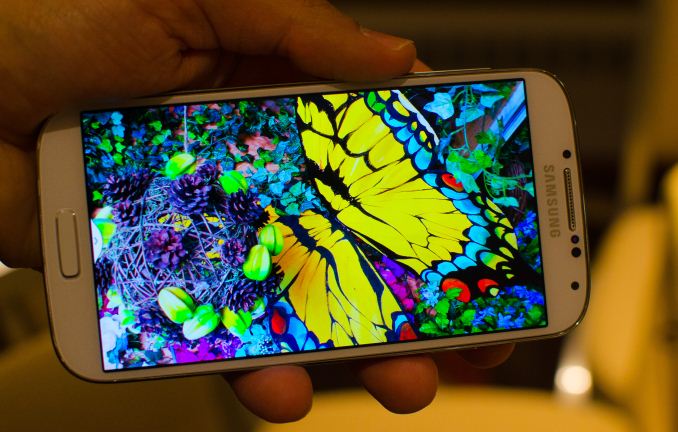
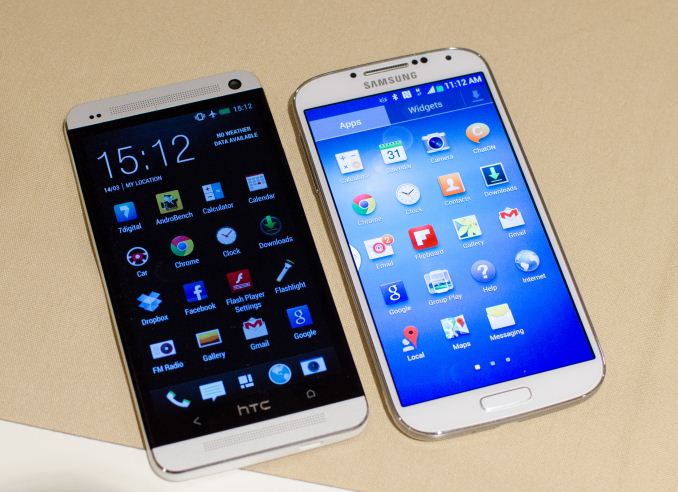

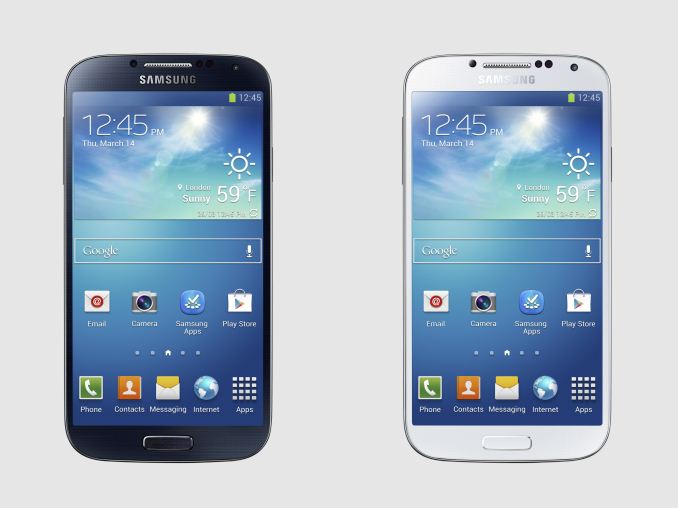
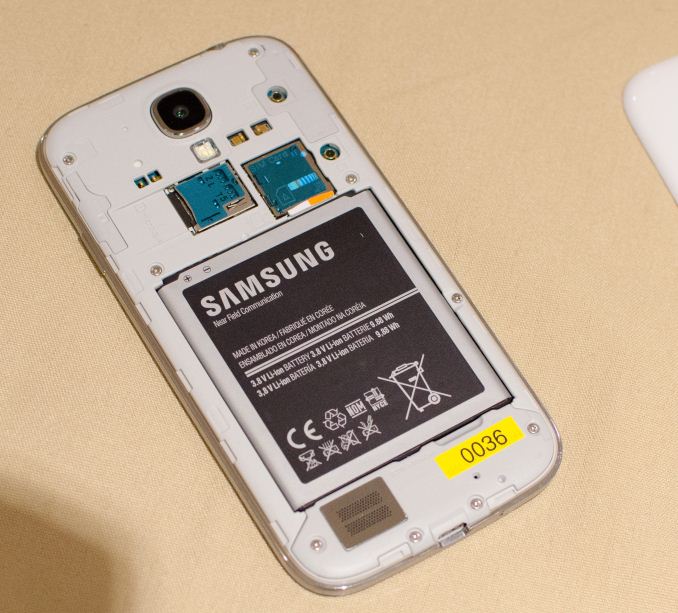
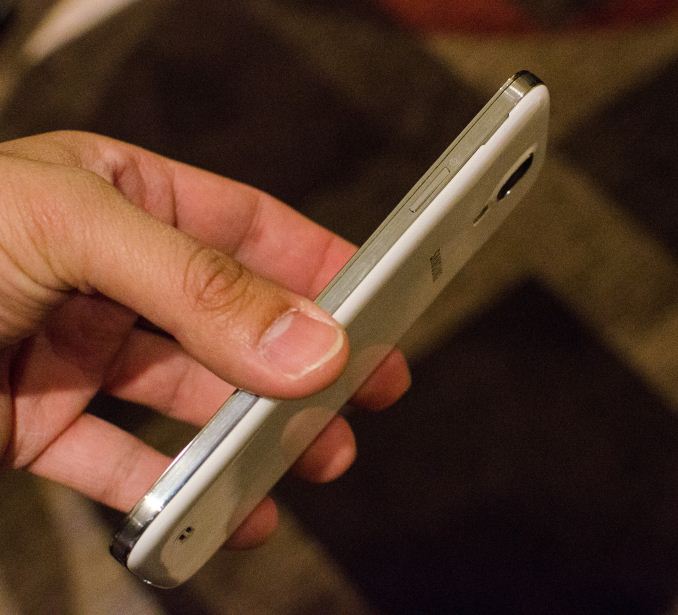















206 Comments
View All Comments
10101010 - Friday, March 15, 2013 - link
No one knows for sure yet about the international S4, but the USA/Qualcomm S4 most likely has a Qualcomm DAC, just as the S3 did.hsew - Friday, March 15, 2013 - link
Samsung, never stop giving us removable storage and battery please. The HTC one was so close to getting it right.If the A15 cores in the Octa are really clocked at JUST 1.2 Ghz, then it may not be as fast as all the excited international folks keep claiming it will be. I would personally prefer the Snapdragon 600. I can't imagine overclocking the asymmetrical Octa will be as easy as overclocking the simpler 600.
The 600's cores are also apparently tweaked A15 cores with a 15% IPC increase. The 600 vs the Octa is ARM's Core i5 vs Bulldozer.
Of course, this is assuming that the Octa's A15 cores are actually clocked at JUST 1.2 Ghz. At 1.6 Ghz the advantage of the 1.9 Ghz 600 diminishes, but people, do remember that these are still just phones, not workstation computers...
lmcd - Saturday, March 16, 2013 - link
Uhhh, the 600 isn't using A15s, but besides that...And "tweaked" doesn't mean +15%.
Snapdragon 600 is probably the better chip, though probably not in terms of graphics unless the 600 has a way clocked-up version of that in the S4 Pro (Snapdragon 400)
CeriseCogburn - Saturday, March 16, 2013 - link
You people... no you're not on the internet....http://www.youtube.com/watch?v=zPaIA16VqQI
quadrant 11782
antutu 20105
vellamo 2076 824
snapdragon 600 @ 1.89
10101010 - Friday, March 15, 2013 - link
One thing that is abundantly clear from the launch of the S4 is that Samsung understands the future. They understand that mobile devices are the personal computers of the future and that the ability to do a variety of things with the device is important. So they have more sensors, more camera capabilities, apps for health and fitness, more input forms, etc. It is an expansion of capabilities for the human user of the device. And this is going to be what wins the market over time. Google understands this as well which is why their Moto X phone will be very capable as well. These are the two companies that will dominate over the next decade or two.IKeelU - Friday, March 15, 2013 - link
Everyone understands this, not just Google and Samsung. This was the future 30 years ago when PCs started becoming popular and it continues to be with virtually every computing device. Consoles became entertainment hubs, phones started to do email (then everything). Cramming more into the device has been the driving force of all tech-oriented marketing since forever.10101010 - Friday, March 15, 2013 - link
Understanding takes many forms. And the depth of this understanding will determine market success. Look at HTC, Nokia, etc. They basically copy Apple's approach to things which is to make the phone simple. There are no added capabilities such as pedometer, temperature, humidity, more input modes other than touch, camera-based user sensing, etc.In Apple's case, there is a flexible interface that allows for many third party add-ons. But Apple's approach doesn't scale nearly as well (from either a cost or convenience perspective) as putting these sensors and features into the phone itself. In the market, Samsung is emerging as a big winner. And they have much more velocity in the market compared to Apple. Google is coming up fast. Google's future phones will have language/information processing capabilities that make other smart phones look dumb.
In short, Samsung gets it. They're making the right decisions, the right investments. HTC, Nokia, etc. are just trying to be Apple for Android or Apple for Windows Phone and largely failing in the market. At best, they will be niche players because their understanding is surface level only.
CeriseCogburn - Saturday, March 16, 2013 - link
Yes and that translates to (appl nokia htc) their tech SUCKS.That's why a frikkin rectangle is an "awesome industrial design", why black or white is "awesome!" and why a lead metal sharp squared weight is "good build for arthritis and hand pain!!!"
The level of immensely stupid populace wide and at nearly all tech sites is incredible.
WaltC - Saturday, March 16, 2013 - link
I don't know anyone who "understands" this...;) What I understand is that cell phones will continue to be used primarily as cell phones with all of the limitations inherent in mobile, battery-driven devices designed to fit in the palm of your hand. Try running Crysis 3 on your cell phone, or try having friends over to play co-op games or watch the latest movie--not going to happen on a cell phone, that's for sure. (Can you imagine two couples sitting on a sofa and sharing the latest movie on a 5-inch cell phone screen? I can't.) Trust me--the RGB monitor did not replace the television in the home, and the cell phone is not going to replace the personal computer. The whole cell-phones-are-going-to-replace-the-personal-computer mantra is stupid in the extreme. Sounds like propaganda coming from folks who a)don't like personal computers and b) are frustrated by personal computers. People will still be buying personal computers 20 years from now, and people will still be buying cell phones. One device does not obfuscate the other. And one device never will "do it all." The either-or mentality is just lame.lmcd - Saturday, March 16, 2013 - link
Doesn't understand that Snapdragon's gonna beat their in-house chip AGAIN...